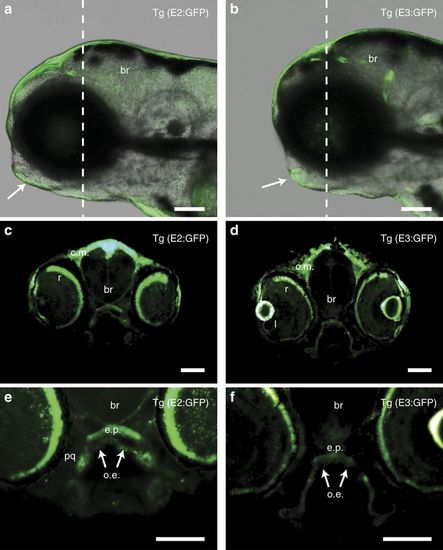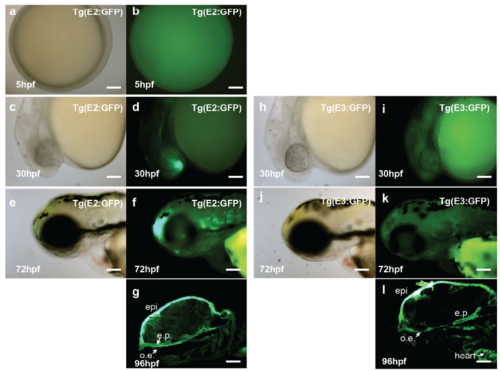- Title
-
Identification of common non-coding variants at 1p22 that are functional for non-syndromic orofacial clefting
- Authors
- Liu, H., Leslie, E.J., Carlson, J.C., Beaty, T.H., Marazita, M.L., Lidral, A.C., Cornell, R.A.
- Source
- Full text @ Nat. Commun.
|
Stable transgenic zebrafish lines showing in vivo enhancer activities patterns of E2 and E3 in craniofacial region. (a,b) Z-stacks from confocal imaging of live stable (F1) transgenic GFP-reporter lines for (a) E2 and (b) E3 at 4 d.p.f. (representative of F1 lines from at least three independent F0 founders). Arrows indicate GFP expression in ventral epithelium and oral epithelium. White dashed lines in a,b indicate section planes in c–f, respectively. (c–f) Transverse sections (12 μm) of stable GFP-reporter lines of E2 (c,e) and E3 (d,f) show in vivo activity of E2 in head epidermis, retina (r), lens (l), ethmoid plate (e.p.), oral epithelium (o.e., white arrow), brain (br) and palatoquadrate (pq). Scale bars=100 μm. EXPRESSION / LABELING:
|
|
Stable transgenic zebrafish lines showing in vivo enhancer activities patterns of E2 and E3 in different development stages. In 5hpf, F2 embryos of Tg(E2:GFP) exhibit universal enhancer activity (a, b). In 30 hpf, F2 embryos of Tg(E2:GFP) exhibit GFP activity in the forebrain (c, d), and F2 embryos of Tg(E3:GFP) exhibit GFP activity in central nervous system (h, i). In 72 hpf, F2 embryos of Tg(E2:GFP) exhibit GFP activity in lower jaw, otic vesicle, head epidermis and forebrain (e, f), and F2 embryos of Tg(E3:GFP) exhibit GFP activity in lower jaw and head epidermis (j, k). In 96hpf, sagittal section of F2 embryos of Tg(E2:GFP) (g) showing in vivo activity of E2 in oral epithelium (o.e.), ethmoid plate (e.p.) and head epidermis (epi), and sagittal section of F2 embryos of Tg(E3:GFP) (l) showing in vivo activity of E3 in oral epithelium, ethmoid plate, head epidermis and heart. Scale bar =100μm. |


